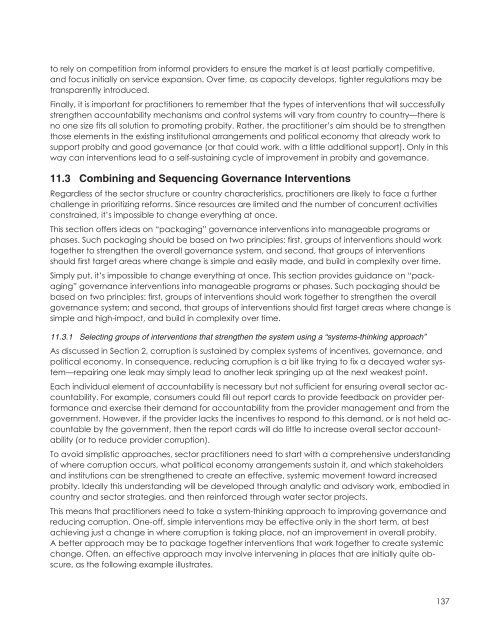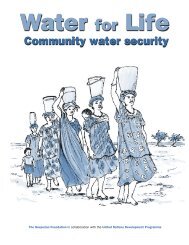A Sourcebook - UN-Water
A Sourcebook - UN-Water
A Sourcebook - UN-Water
Create successful ePaper yourself
Turn your PDF publications into a flip-book with our unique Google optimized e-Paper software.
to rely on competition from informal providers to ensure the market is at least partially competitive,<br />
and focus initially on service expansion. Over time, as capacity develops, tighter regulations may be<br />
transparently introduced.<br />
Finally, it is important for practitioners to remember that the types of interventions that will successfully<br />
strengthen accountability mechanisms and control systems will vary from country to country—there is<br />
no one size fits all solution to promoting probity. Rather, the practitioner’s aim should be to strengthen<br />
those elements in the existing institutional arrangements and political economy that already work to<br />
support probity and good governance (or that could work, with a little additional support). Only in this<br />
way can interventions lead to a self-sustaining cycle of improvement in probity and governance.<br />
11.3 Combining and Sequencing Governance Interventions<br />
Regardless of the sector structure or country characteristics, practitioners are likely to face a further<br />
challenge in prioritizing reforms. Since resources are limited and the number of concurrent activities<br />
constrained, it’s impossible to change everything at once.<br />
This section offers ideas on “packaging” governance interventions into manageable programs or<br />
phases. Such packaging should be based on two principles: first, groups of interventions should work<br />
together to strengthen the overall governance system, and second, that groups of interventions<br />
should first target areas where change is simple and easily made, and build in complexity over time.<br />
Simply put, it’s impossible to change everything at once. This section provides guidance on “packaging”<br />
governance interventions into manageable programs or phases. Such packaging should be<br />
based on two principles: first, groups of interventions should work together to strengthen the overall<br />
governance system; and second, that groups of interventions should first target areas where change is<br />
simple and high-impact, and build in complexity over time.<br />
11.3.1 Selecting groups of interventions that strengthen the system using a “systems-thinking approach”<br />
As discussed in Section 2, corruption is sustained by complex systems of incentives, governance, and<br />
political economy. In consequence, reducing corruption is a bit like trying to fix a decayed water system—repairing<br />
one leak may simply lead to another leak springing up at the next weakest point.<br />
Each individual element of accountability is necessary but not sufficient for ensuring overall sector accountability.<br />
For example, consumers could fill out report cards to provide feedback on provider performance<br />
and exercise their demand for accountability from the provider management and from the<br />
government. However, if the provider lacks the incentives to respond to this demand, or is not held accountable<br />
by the government, then the report cards will do little to increase overall sector accountability<br />
(or to reduce provider corruption).<br />
To avoid simplistic approaches, sector practitioners need to start with a comprehensive understanding<br />
of where corruption occurs, what political economy arrangements sustain it, and which stakeholders<br />
and institutions can be strengthened to create an effective, systemic movement toward increased<br />
probity. Ideally this understanding will be developed through analytic and advisory work, embodied in<br />
country and sector strategies, and then reinforced through water sector projects.<br />
This means that practitioners need to take a system-thinking approach to improving governance and<br />
reducing corruption. One-off, simple interventions may be effective only in the short term, at best<br />
achieving just a change in where corruption is taking place, not an improvement in overall probity.<br />
A better approach may be to package together interventions that work together to create systemic<br />
change. Often, an effective approach may involve intervening in places that are initially quite obscure,<br />
as the following example illustrates.<br />
137
















